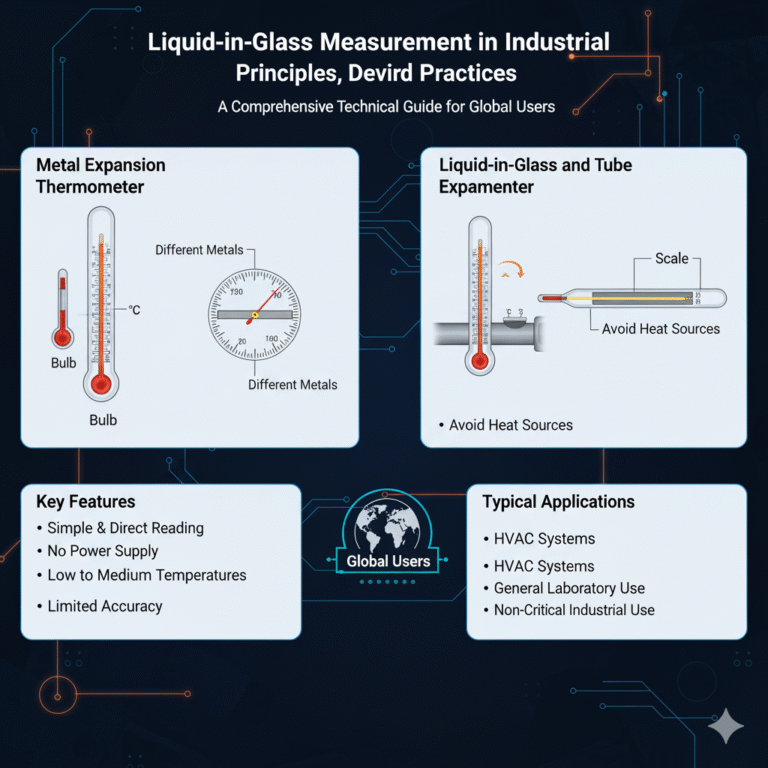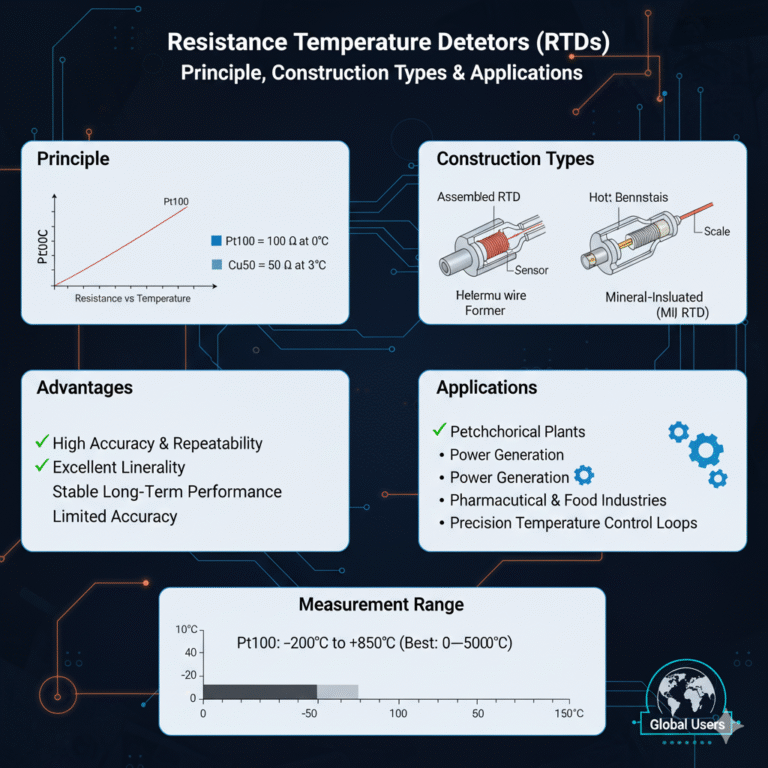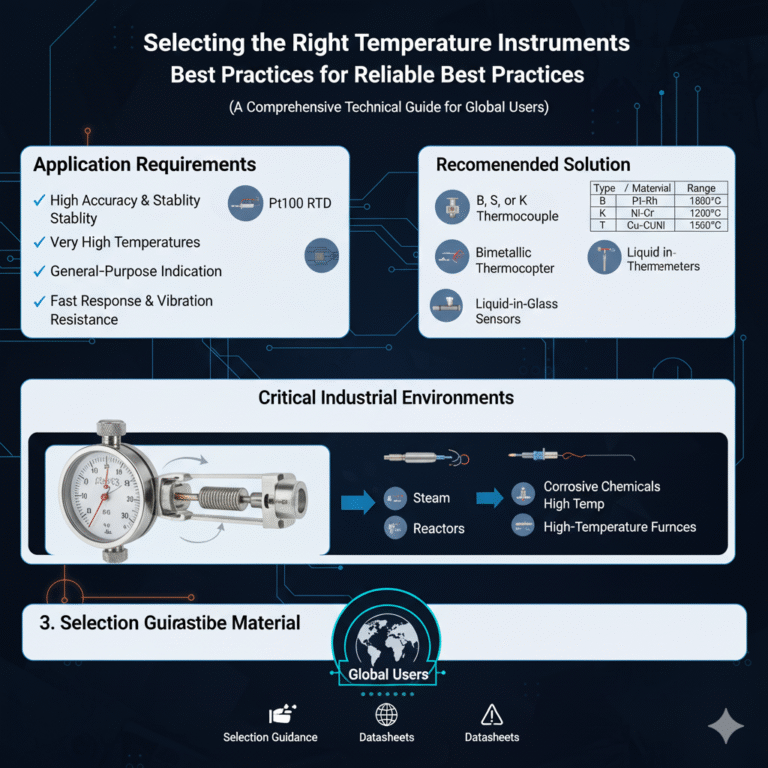Introduction
Temperature is one of the most fundamental and widely measured parameters in industrial processes. Nearly 50% of all process control applications involve temperature monitoring, and accurate temperature measurement is essential for product quality, equipment safety, energy efficiency, and overall plant reliability.
Because temperature cannot be sensed directly, it must be measured through the physical properties of materials that vary with thermal changes—such as electrical resistance, thermal expansion, or thermoelectric effects.
This article provides a clear, professional overview of the main temperature measurement technologies used today, their operating principles, typical applications, strengths, and limitations.

Temperature Scales and Conversions
Three temperature scales are commonly used in industrial and scientific settings:
Celsius (°C) — widely used in most regions
Fahrenheit (°F) — primarily used in the United States
Kelvin (K) — the standard thermodynamic scale used in engineering and research
Their relationships are:
°C = (°F − 32) × 5/9
K = °C + 273.15
Understanding these scales and conversions is essential for international engineering teams and instrumentation calibration.
Classification of Common Temperature Measurement Technologies
Industrial temperature instruments fall into four principal categories:
1. Liquid-in-Glass and Thermal Expansion Thermometers
Principle
These devices rely on the thermal expansion of liquids (alcohol or mercury) or metals when temperature changes.
Key Features
Simple and direct reading
No power supply required
Suitable for low to medium temperature applications
Limited accuracy and not suitable for advanced process control
Typical Applications
Boilers
HVAC systems
General laboratory use
Non-critical industrial pipelines

2. Bimetallic Thermometers
Principle
A bimetallic thermometer contains two bonded metal strips with different thermal expansion coefficients. As temperature changes, the strip bends, driving the pointer on a dial.
Advantages
Rugged and inexpensive
Fast response
Suitable for on-site indication
Limitations
Lower accuracy (Class 1.0, 1.5, or 2.5)
Not ideal for data logging or high-precision control
Applications
Food processing
Chemical pipelines
Mechanical equipment monitoring
Outdoor temperature indication
3. Resistance Temperature Detectors (RTDs)
RTDs—particularly Pt100 and Pt1000—are the most widely used sensors where high accuracy and stability are required.
Principle
RTDs utilize the predictable change in electrical resistance of metals (usually platinum) with temperature.
For example:
Pt100 = 100 Ω at 0°C
Cu50 = 50 Ω at 0°C
Measurement Range
Pt100: –200°C to +850°C (best performance within 0–500°C)
Cu50: –50°C to +150°C
Advantages
High accuracy and repeatability
Excellent linearity
Stable long-term performance
Construction Types
Assembled RTDs: with protection tubes
Mineral-insulated (MI) RTDs: flexible, vibration-resistant, faster response
Applications
Petrochemical plants
Power generation
Pharmaceutical and food industries
Precision temperature control loops

4. Thermocouples
Thermocouples are the preferred sensors for high-temperature and wide-range industrial applications.
Principle
When two dissimilar metals are joined together, they generate a voltage (thermo-EMF) proportional to the temperature difference between the measurement junction and the reference junction.
Thermocouples are defined by their type—representing the metal materials used:
| Type | Material Composition | Typical Range |
|---|---|---|
| B | Pt-Rh30 / Pt-Rh6 | 600–1800°C |
| S | Pt-Rh10 / Pt | 0–1600°C |
| K | Ni-Cr / Ni-Si | –200–1200°C |
| E | Ni-Cr / Cu-Ni | –200–900°C |
| T | Cu / Cu-Ni | –200–350°C |
| J | Fe / Cu-Ni | –40–750°C |
Advantages of Thermocouples
Extremely wide measuring range
Fast response
Simple structure and durable
Suitable for long cable runs
Use of Compensation Cables
Each thermocouple type requires matching extension wires to maintain accuracy. Using the wrong compensation cable can cause significant measurement errors.
Typical Industrial Applications
Furnaces and kilns
Refinery heaters
Glass and steel production
High-temperature reactors
Exhaust and flue gas measurement
Installation Considerations for Temperature Sensors
Correct installation is essential for achieving reliable temperature measurements. Key recommendations include:
1. Proper immersion length
Sensors must be immersed deep enough in the process medium to avoid heat conduction errors.
General guideline: Immersion length ≥ 10–15 times the sensor diameter
2. Avoid installation near heat sources or dead zones
Ensure turbulent flow around the sensor to obtain a representative temperature profile.
3. Choose the correct protection tube material
Depending on media:
Stainless steel for water, oil, general chemicals
Inconel or Hastelloy for corrosive or high-temperature environments
Ceramic tubes for extreme temperatures
4. Use thermal paste or proper contact surfaces for surface-mount sensors.
5. Follow international standards
Sensors and installation should comply with:
IEC 60751 for RTDs
IEC 60584 for thermocouples
DIN, ANSI, or JIS flange connection standards

Accuracy, Calibration, and Common Error Sources
Accurate temperature measurement depends not only on choosing the right sensor but also on proper calibration and maintenance.
Common Error Sources
Poor contact or insufficient insertion depth
Selection of incorrect thermocouple type
Using unmatched extension cables
Oxidation or corrosion of sensor materials
Thermal lag due to oversized protection tubes
Electrical noise in long cable runs
Calibration Best Practices
Perform periodic calibration based on process requirements
Use certified equipment traceable to national standards
For thermocouples, check the condition of the measurement junction regularly
For RTDs, test insulation resistance and lead wire integrity
Selecting the Right Temperature Instrument
Choosing the proper sensor depends on the process conditions:
| Requirement | Recommended Solution |
|---|---|
| High accuracy and stability | Pt100 RTD |
| Very high temperatures | B, S, or K thermocouple |
| General-purpose pipeline indication | Bimetal thermometer |
| Low-cost applications | Liquid-in-glass thermometer |
| Fast response & vibration resistance | Mineral-insulated sensors |
For critical industrial environments—such as steam, corrosive chemicals, reactors, and high-temperature furnaces—thermocouples and MI-RTDs are generally preferred.

Conclusion
Temperature is a critical variable in nearly every industrial process, and choosing the right measurement technology is essential for accuracy, safety, and efficiency. By understanding the principles of RTDs, thermocouples, bimetal thermometers, and thermal expansion devices—as well as applying proper installation and calibration practices—engineers can significantly improve process performance and reliability.
If you require selection guidance, datasheets, or customized temperature probes (RTD, thermocouple, high-temperature sensors, or sanitary designs), our technical team is ready to support your application needs.
